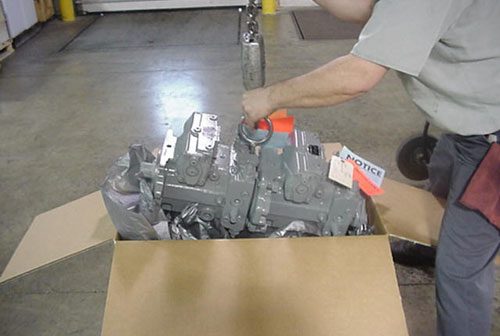
Quality, cost and overall value have always been important considerations when it comes to hydraulic repair. But some industry experts say the influx of aftermarket replacement parts, mostly from China, have tilted the value scale to the low end—and equipment users are the ultimate losers.
As a bit of background, the majority of hydraulic repair shops in the U.S. are small, “mom-and-pop” shops that do everything from crimping hose to fixing pumps. They say the big hydraulic component manufacturers generally have viewed them with a laissez-faire attitude in terms of engineering support and availability and price of repair parts. Hydraulics manufacturers counter that small shops rarely invest in the latest technology, test equipment and training to facilitate high-quality repairs.
Regardless of who’s at fault, economic strains in the slow-growth U.S. market have smaller repair companies under pressure to cut costs. And as a result, it created a foothold for low-cost Chinese aftermarket parts.
“The Chinese presence in the hydraulic component replacement market is enormous as compared to 10 or 15 years ago,” said Pat Dearmond, director of marketing and sales with hydraulic remanufacturer Engineering Technology Services. “No doubt the aftermarket route can be cheaper,” he said, and unfocused, saturation marketing via the Internet makes anyone a customer.
“We worry that in the long run it takes a toll on quality,” he said. “At ETS, we remind customers of the pitfalls and dangers of reverse-engineered components. Every aftermarket part is copied from an original OEM part and has widely varying degrees of dimensional tolerances. If they’re too high or too low the result is a pump or motor that fails or underperforms.” He has seen problems like porosity, improper-size bearings and out-of-spec material hardness, just to name a few. That leads to poor longevity, compared to repairs using OEM components.
Asian components on the market are a real challenge, agrees Steve Matthew, president of Wooster Hydrostatics. “We contend that the only way to repair a unit properly is to use parts sourced directly from the OEM. We structure our business around that and believe that gives our customers the best value and the best product, and is also why we can warrant rebuilt units as new.
“Parts from the OEM are specified properly and we know exactly what we’re getting. Buying from a non-OEM parts supplier means you’re relying on their “knock-off” capability to make sure the part is right. We’re not willing to take that risk. Because of the lack of quality in some cases, there’s no doubt that “gray-market” parts can give the industry a black eye.”
The insidious side of sub-par quality is that many end users don’t even know if a component, say a Parker or Rexroth pump, gets repaired with OEM or aftermarket parts. But if it fails in short order, the original manufacturer often gets the blame.
The trend toward sub-standard hydraulic repair has some users foregoing rebuilds entirely. Though more expensive, when something breaks they simply replace it with a brand new unit. But it’s better than getting burned spending time and money on a repair that quickly fails, and having to do it all over again. Either way, though, it drives up costs.
Hydraulics OEMs seem to be coming around to the fact that sub-standard parts and repairs hurt their bottom line in terms of both brand reputation and market share lost to aftermarket suppliers. The question is, will fluid-power OEMs make the investments to ensure widespread availability of original parts, reasonable prices, component repair exchange, and 24-hr turnaround? Or will they cede most of the market to offshore aftermarket manufacturers? If it’s not addressed in the next few years, it’s ultimately to the detriment of most hydraulics users.

